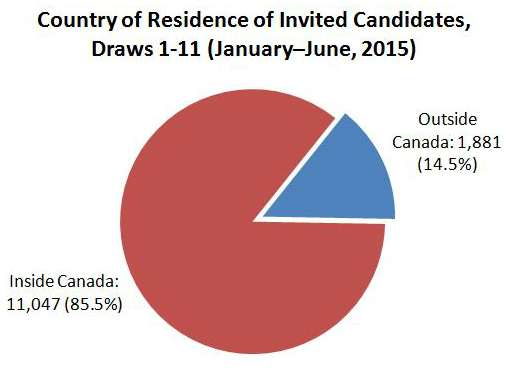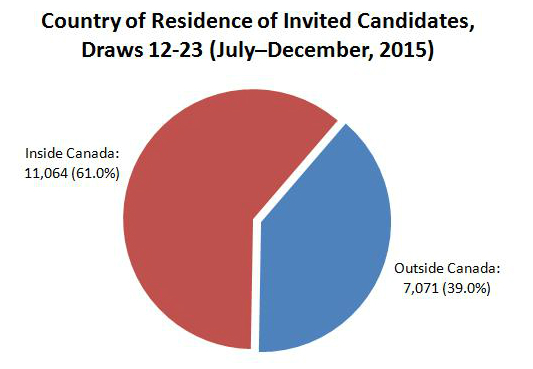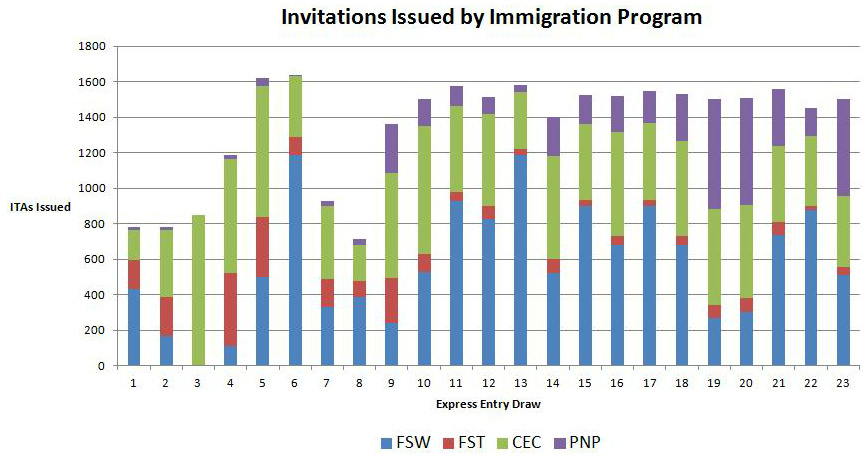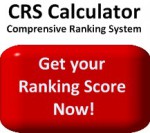Express Entry Exclusive: Increasing Number of Candidates Outside Canada Selected for Immigration
 Over the second half of 2015, 39% of all invited candidates resided outside Canada
Over the second half of 2015, 39% of all invited candidates resided outside Canada
Earlier this month, CICNews.com published a series of in-depth articles covering the latest report on the Express Entry selection system for immigration to Canada. Based on all reports provided thus far, we can confirm that the number of candidates in the pool residing outside Canada who received Invitations to Apply (ITAs) for permanent residence in the latter half of 2015 increased significantly.
The latest report, which provided data on the first 12 months (23 draws) of Express Entry, was produced by Immigration, Refugees and Citizenship Canada (IRCC, formerly known as CIC). It followed a similar report that was produced last July. By comparing the two reports, we can arrive at some hard conclusions:
- In the first 11 draws from the pool, 85.5% of invited candidates were residents of Canada.
- Over the following 12 draws, however, this figure dropped to 61%, meaning that 39% of invited candidates over that period were residing outside Canada.
- As more draws occurred, a wider spread of countries of residence for invited candidates became apparent.
According to the year-end report, earlier draws from the pool selected a large number of candidates under the Canadian Experience Class (CEC). This was because of the high number of foreign workers with Labour Market Impact Assessment-backed job offers who wished to immigrate to Canada permanently. Indeed, the third draw from the pool selected CEC candidates exclusively. This had the effect of inflating the relative number of invited candidates residing inside Canada who were drawn soon after the Express Entry system came into operation.
Not only were an increasing number of international candidates (i.e. not based in Canada) invited to apply as 2015 developed, but the report also states that ‘future invitation rounds from the Express Entry pool will become the main source of applications to meet annual immigration levels targets for certain economic immigration programs under the Express Entry system as the older inventories are reduced.’ (The ‘older inventories’ refers to applications submitted before 2015 that remained in processing after Express Entry was launched in January, 2015.)
With these factors in mind, the relative number of invited candidates residing outside Canada may continue to increase through 2016, just as it did as we moved deeper into 2015.

As stated above, the residing-in-Canada figure over the first few months of Express Entry (covering the first 11 draws) was artificially high, as IRCC/CIC selected many foreign workers already in Canada. Once these candidates were drawn, there were fewer Canada-based foreign workers in the pool left to be drawn.
Consequently, the portion of Canada-based candidates dropped into the second half of 2015. This, of course, led to an increase in the number of invited candidates who were residing in different countries around the world. Further, the spread of countries became far more varied. Over the first 11 draws, the top nine countries together made up 94.8% of all invited candidates. Over the following 12 draws, however, this figure dropped to 76.1%.

Comparing the two sets of data reveals that only two countries (Canada and the Philippines) had an absolute decrease in the number of invited candidates as we moved deeper into 2015 (and in the case of the Philippines, the change was marginal). Every other country saw an increase, and the ‘Other’ portion increased dramatically.
In addition, it should be noted that the overall number of invited candidates increased as time moved on. A total of 12,928 ITAs were issued over the first 11 draws, while the following 12 draws saw 18,135 ITAs issued. Moreover, a further 10,419 ITAs have already been issued so far in 2016.
International candidates and the Comprehensive Ranking System (CRS)
The above information is very useful, but begs the question as to how this increase in international candidates (i.e. not residing in Canada) has taken place, and why. Fortunately, the data provided in the report, in addition to things we already knew, allows us to reach some conclusions.
First, it should be noted that a large number of CRS points may be awarded for language ability and level of education. Together, these factors are worth up to 310 points (out of 500 for overall core human capital) for a single applicant, and 320 points for candidates with an accompanying spouse or common-law partner. In contrast, a maximum of only 80 points (out of 500) may be awarded to candidates with Canadian work experience.
In addition, language and education are heavily in play when it comes to skills transferability, with up to 100 more points available in this area. Educated candidates with strong language skills are benefiting under the CRS.
Understanding “Core” CRS score
Another group of individuals that are benefiting under the Express Entry system are candidates with modest “Core” CRS scores. Core CRS indicates a candidate’s score without the additional 600 points for a job offer or a provincial nomination.
The table below shows the distribution of active candidates in the Express Entry pool and invitations issued over the course of 2015, broken down by Core CRS score. The ‘# of Active Candidates’ column represents a data extract from January 3, 2016.

As depicted above, more candidates with Core CRS scores of less than 450 have been selected than candidates with 450 or more points. For many candidates in the pool, this news may come as something of a revelation, as the 450 threshold (the lowest CRS point requirement of any draw so far) is not as unattainable as it may first seem. Indeed, taking the range of candidates with Core CRS scores of 450 or below, a plurality of invited candidates had Core CRS scores in the 200–249 range. In fact, more than six times as many candidates in this range had been invited to apply than were left in the pool when the data extract (or ‘snapshot’) was pulled on January 3, 2016.
Provincial Nominee Programs and Job Offers
These candidates are benefiting from the 600 additional CRS points that are available to individuals who obtain either an enhanced provincial nomination certificate or a qualifying job offer.
Over the course of 2015 and into 2016, Canadian provinces engaged more actively with the system and issued an increasing number of enhanced provincial nomination certificates, which consequently led to an increase in PNP invitations. Throughout 2015, a significant number of candidates were issued invitations under the Federal Skilled Worker Class (FSWC), while a small, but steady, number of invitations were issued under the Federal Skilled Trades Class (FSTC).
Other proactive candidates around the world have managed to reach out to Canadian employers and promote their skills and experience, ultimately being rewarded with job offers supported by a LMIA.
Of the 31,063 ITAs issued during 2015, a total of 13,214 (42.6%) of them were issued under FSW, 11,228 (36.1%) were issued under CEC, 4,105 (13.2%) were issued under PNP, and 2,516 (8.1%) were issued under FST. The chart below shows the extent to which PNPs became a factor as provinces became more engaged with the system.

Sixty percent of all invited candidates had 600 points or more (i.e. they had either a qualifying job offer or provincial nomination certificate). For more information on draws from the Express Entry pool that have taken place so far, click here.
Canada is looking far and wide around the world
“When reading the two major reports that IRCC has provided, the real story is that Express Entry has developed — and continues to develop — into a truly global immigration selection system. With hard data available, we can see that the number of candidates residing around the world who received ITAs in 2015, in both percentage and absolute terms, increased as the year went on. What began as something of an anomaly, with a large number of Canada-based foreign workers being selected around this time last year, has moved on to something far more international in scope,” says Attorney David Cohen.
“Additionally, the data shows that Express Entry has ultimately selected a large number of candidates who entered the pool with Core CRS scores below 450.
“Consequently, there are two major takeaways: the number of candidates outside Canada selected for immigration has been going up, and the spread of Core CRS scores among invited candidates has been very wide. Therefore I would encourage individuals around the world thinking of immigrating to Canada to create an Express Entry profile in short order. Then they can attract the attention of Canadian provinces and employers, while also aiming to increase their Core CRS scores.
Eligible candidates may submit a profile into the Express Entry pool, where they are ranked according to the CRS. The government of Canada selects the top-ranked candidates on a priority basis when it performs one of its frequent draws from the pool.
Candidates who are issued an ITA for permanent residence then have 60 days to submit a complete e-application, from which point the government of Canada aims to process the application within six months. For more information on draws from the Express Entry pool that have taken place so far, click here.
To find out if you are eligible for any of over 60 Canadian immigration programs, including the federal economic programs that are processed under Express Entry, please fill out a free online assessment today.
© 2016 CICNews All Rights Reserved
- Do you need Canadian immigration assistance? Contact the Contact Cohen Immigration Law firm by completing our form
- Send us your feedback or your non-legal assistance questions by emailing us at media@canadavisa.com





